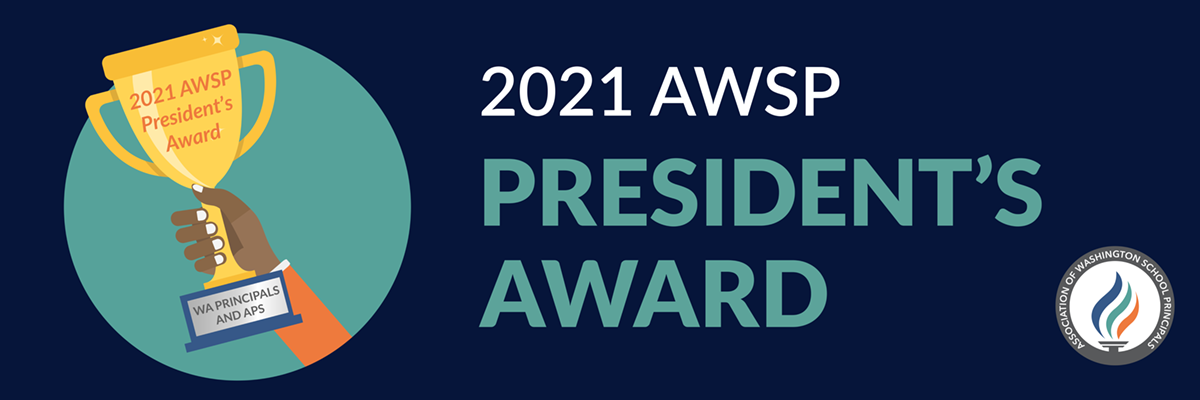by
David Morrill
| Jul 12, 2021

Some dream about winning an Emmy, Grammy, or Golden Globe Award. Others fantasize about walking to the stage to accept an Academy Award. Some dream of ticker tape, fireworks, and packed stadiums while being crowned a Super Bowl, Stanley Cup, WNBA, or
World Series Champ. Others dream about stepping up on the Olympic podium as a new world record holder gold medalist. While others place their life’s work into winning a Nobel Peace Prize. And, finally, of course, above all recognition, the world
waits with bated breath for the annual AWSP President’s Award.
That’s right. An award greater than all awards and recognition across the globe. More noble, more prestigious, more meaningful, impactful, and life-changing. An award that reaches deep into humanity focusing on improving society, shaping futures,
molding communities, and saving lives. An award that recognizes self-sacrifice, dedication, unwavering support of those who need it the most, and the modeling of unconditional love for all. An award that highlights the true definition of determination,
perseverance, and grit.
For decades, the AWSP Board President selects one person in our state every year who tirelessly fights for the work principals and assistant principals do across the state. In the past, this award has been bestowed upon elected officials, state
leaders, and other partners who wholeheartedly believe in the mission of AWSP. The list of names is impressive and their accomplishments inspiring. So, who did this year’s AWSP Board President, Cameron Grow, choose?
You. All of you.
That’s right. You. President Cameron Grow of Lincoln Middle School in Pullman, WA, decided that each and every principal and assistant principal in the state deserved this prestigious recognition. The past 16 months have been unimaginable. The role
our school leaders played during these crazy times is simply astounding and inspiring. No one in the entire system deserves more recognition than you. No one.
So if you haven’t heard the news yet, let me be the first one to congratulate you on your well-deserved and incredible recognition. You are the 2020-21 AWSP President’s Award winner. More than an Academy Award or Olympic Gold Medal, you take
home the prize of all prizes.
Who stood in the gap of uncertainty? You. Who created 29 different master schedules? You. Who worked tirelessly to support students and staff? You. Who delivered technology to homes? You. Who packed meals for families? You. Who responded to ever-changing
guidelines? You. Who worked tirelessly to lead healing and restoration? You. Who took temperatures at the front door? You. Who put your own health and safety behind everyone else? You. Who never gave up? You.
Our society has no idea of what you all just endured as school leaders. Everyone suffered during the last year, but not everyone served as a school leader. Your work is truly unique. There is no job like yours. The stress, anxiety, and pressure you face
has always been relentless. Then throw a pandemic and social unrest into the mix and you’ve got a recipe for, as your Board President said, “the hardest year of my entire career.”
That’s why you are all being recognized. True heroes in our society. None of you stepped into school leadership for fame or fortune. You took on the role to make a difference, change lives, dismantle bad-for-kids systems, and to lead hope. Yes,
it is the toughest job in the system, but it is also the most rewarding. Because of you…your students, staff, and community not only weathered this storm, but came out the other side better prepared to meet the future needs of each and every
student in the system. And yes, I understand that everything takes a team effort, but that team requires leadership, which again is you.
At AWSP, we won’t rest in sharing with the world the continued plight of school leaders. School leadership always mattered, it mattered especially during the last year, and matters even more as we move forward in reimagining how we redefine the
system. We need great leaders like you to stay committed to your roles, your schools, and your communities. Your kids deserve consistent leadership and we will fight to make sure you are supported, encouraged, and compensated accordingly to consistently
get the job done.
So go find a mirror and look straight into it as you hear these words, “And this year’s AWSP President’s incredibly prestigious life-changing award goes to…YOU.”
Congratulations and thank you for your incredible service.
2020-21 President Cameron Grow Presents the Award